Mobilizing Creativity: Royal Court Innovation Strategies (SHR044-6)
VerifiedAdded on 2023/05/28
|14
|3086
|389
Report
AI Summary
This report provides a critical analysis of the climate model and creative leadership/human resource management strategies to promote innovation and creativity within the Diwan of the Royal Court. It examines organizational culture and identifies social and organizational barriers to innovation. The report analyzes various models, including autocratic, custodian, supportive, collegial, and system models, and their impact on organizational climate. It recommends implementing supportive, collegial, and system models, emphasizing participative leadership, employee training, and continuous performance monitoring to foster a culture of innovation. The analysis draws upon academic literature to support its findings and recommendations, aiming to provide actionable insights for the Diwan of the Royal Court to effectively mobilize its employees and enhance its innovative capabilities.
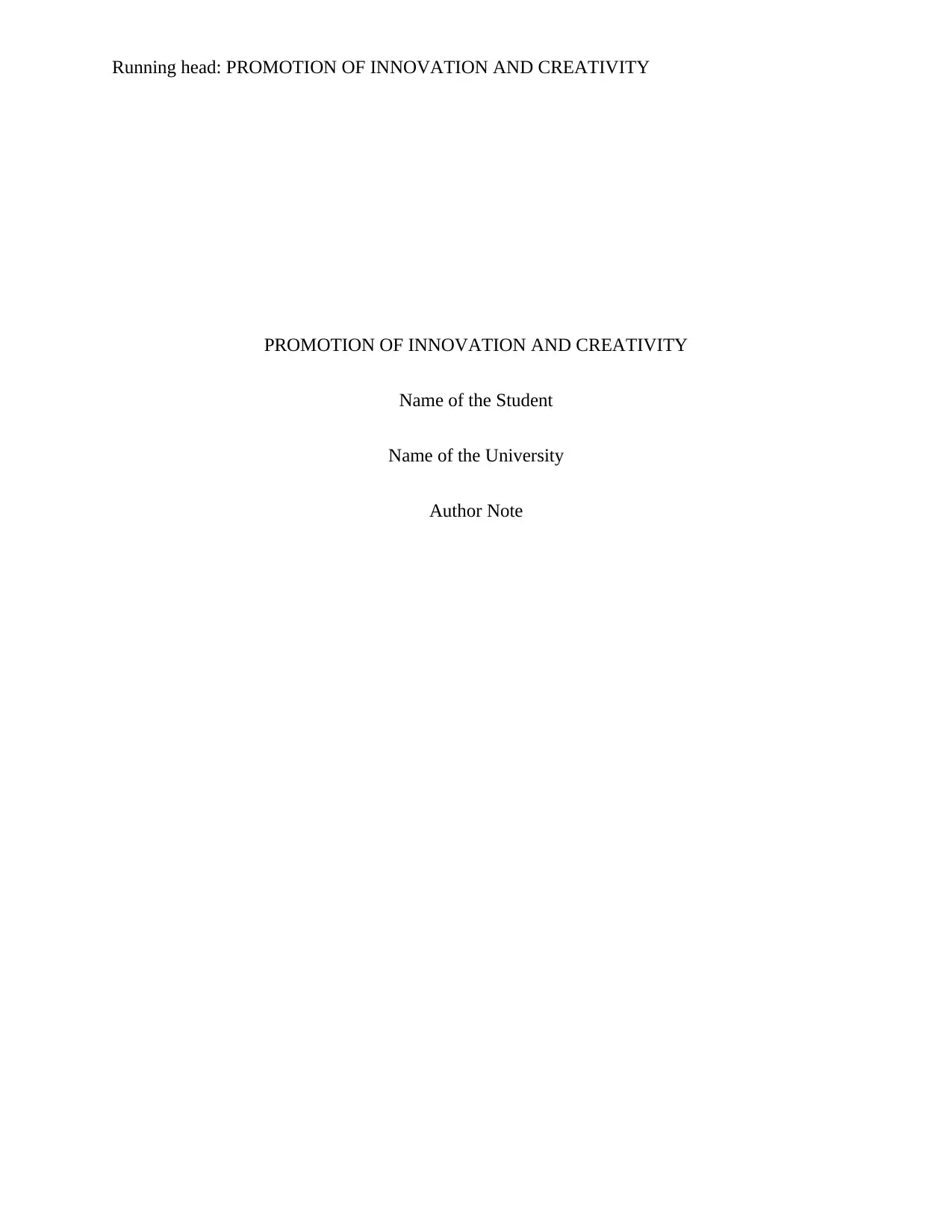
Running head: PROMOTION OF INNOVATION AND CREATIVITY
PROMOTION OF INNOVATION AND CREATIVITY
Name of the Student
Name of the University
Author Note
PROMOTION OF INNOVATION AND CREATIVITY
Name of the Student
Name of the University
Author Note
Paraphrase This Document
Need a fresh take? Get an instant paraphrase of this document with our AI Paraphraser
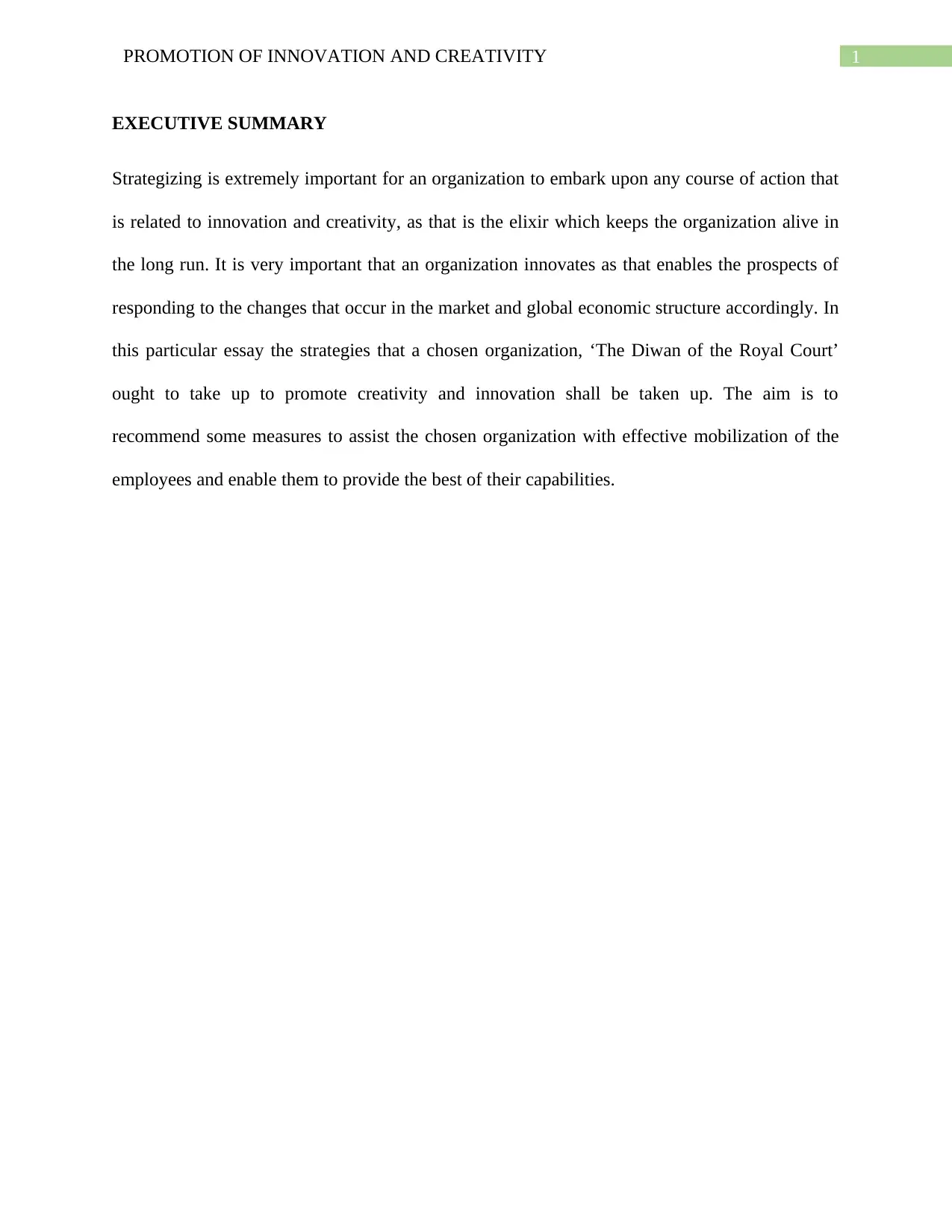
1PROMOTION OF INNOVATION AND CREATIVITY
EXECUTIVE SUMMARY
Strategizing is extremely important for an organization to embark upon any course of action that
is related to innovation and creativity, as that is the elixir which keeps the organization alive in
the long run. It is very important that an organization innovates as that enables the prospects of
responding to the changes that occur in the market and global economic structure accordingly. In
this particular essay the strategies that a chosen organization, ‘The Diwan of the Royal Court’
ought to take up to promote creativity and innovation shall be taken up. The aim is to
recommend some measures to assist the chosen organization with effective mobilization of the
employees and enable them to provide the best of their capabilities.
EXECUTIVE SUMMARY
Strategizing is extremely important for an organization to embark upon any course of action that
is related to innovation and creativity, as that is the elixir which keeps the organization alive in
the long run. It is very important that an organization innovates as that enables the prospects of
responding to the changes that occur in the market and global economic structure accordingly. In
this particular essay the strategies that a chosen organization, ‘The Diwan of the Royal Court’
ought to take up to promote creativity and innovation shall be taken up. The aim is to
recommend some measures to assist the chosen organization with effective mobilization of the
employees and enable them to provide the best of their capabilities.
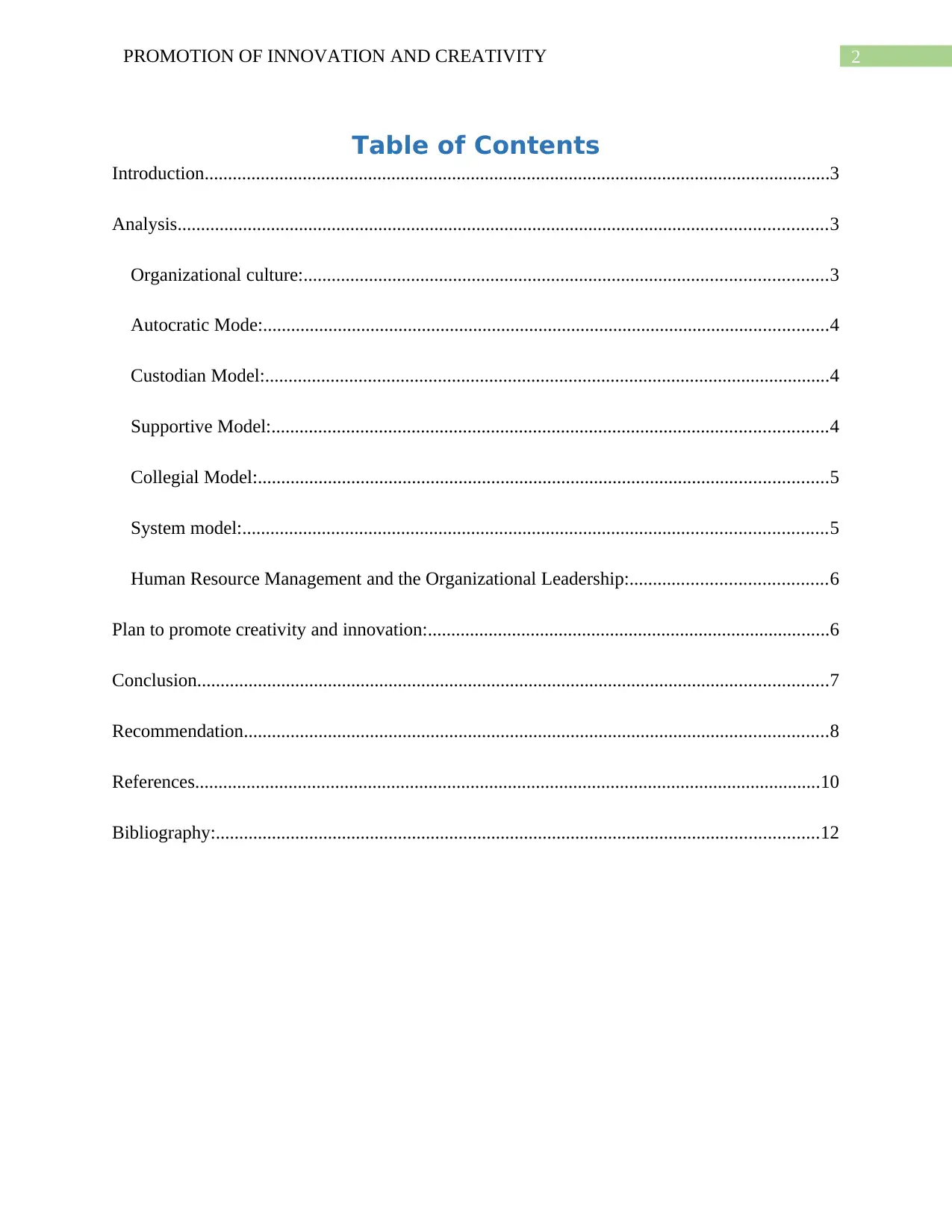
2PROMOTION OF INNOVATION AND CREATIVITY
Table of Contents
Introduction......................................................................................................................................3
Analysis...........................................................................................................................................3
Organizational culture:................................................................................................................3
Autocratic Mode:.........................................................................................................................4
Custodian Model:.........................................................................................................................4
Supportive Model:.......................................................................................................................4
Collegial Model:..........................................................................................................................5
System model:.............................................................................................................................5
Human Resource Management and the Organizational Leadership:..........................................6
Plan to promote creativity and innovation:......................................................................................6
Conclusion.......................................................................................................................................7
Recommendation.............................................................................................................................8
References......................................................................................................................................10
Bibliography:.................................................................................................................................12
Table of Contents
Introduction......................................................................................................................................3
Analysis...........................................................................................................................................3
Organizational culture:................................................................................................................3
Autocratic Mode:.........................................................................................................................4
Custodian Model:.........................................................................................................................4
Supportive Model:.......................................................................................................................4
Collegial Model:..........................................................................................................................5
System model:.............................................................................................................................5
Human Resource Management and the Organizational Leadership:..........................................6
Plan to promote creativity and innovation:......................................................................................6
Conclusion.......................................................................................................................................7
Recommendation.............................................................................................................................8
References......................................................................................................................................10
Bibliography:.................................................................................................................................12
⊘ This is a preview!⊘
Do you want full access?
Subscribe today to unlock all pages.

Trusted by 1+ million students worldwide
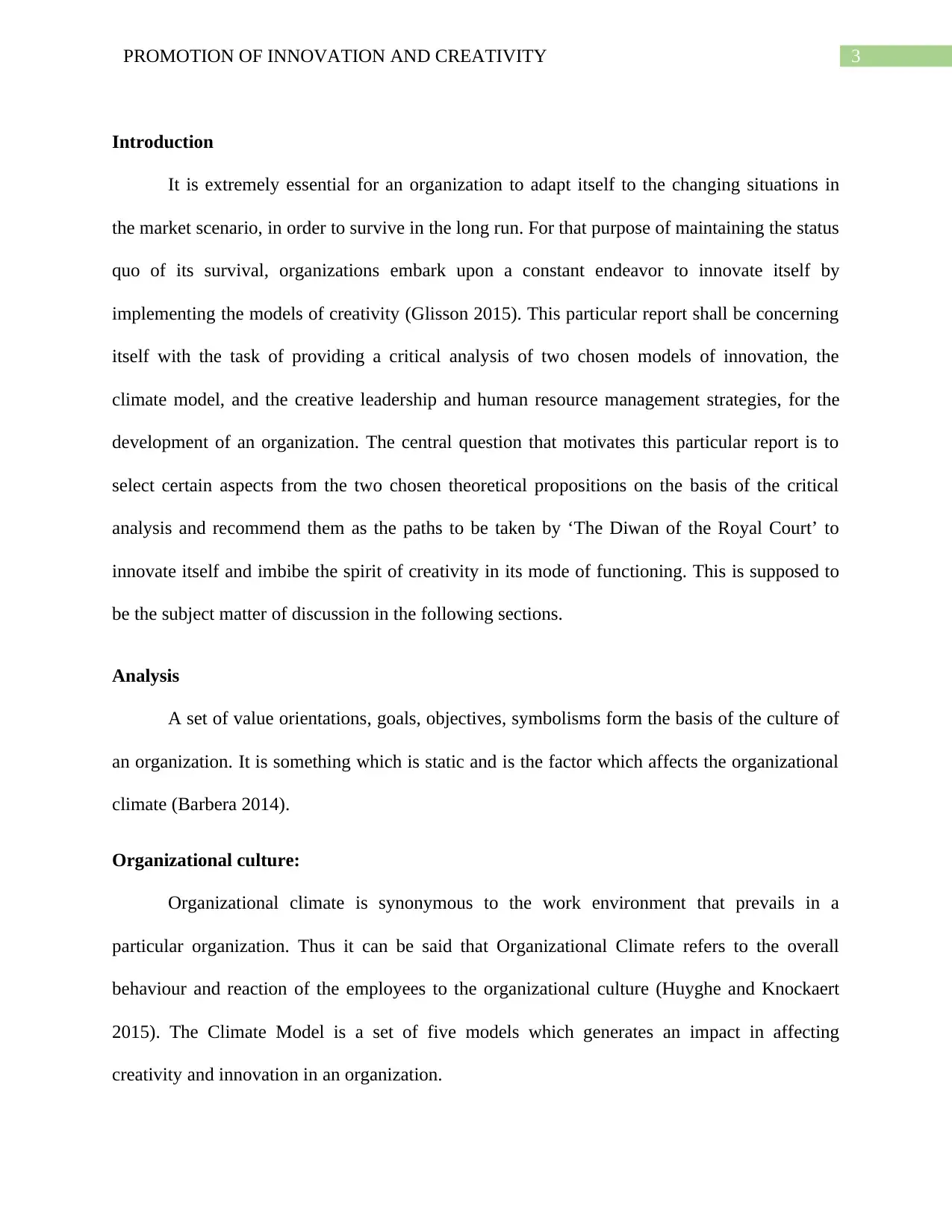
3PROMOTION OF INNOVATION AND CREATIVITY
Introduction
It is extremely essential for an organization to adapt itself to the changing situations in
the market scenario, in order to survive in the long run. For that purpose of maintaining the status
quo of its survival, organizations embark upon a constant endeavor to innovate itself by
implementing the models of creativity (Glisson 2015). This particular report shall be concerning
itself with the task of providing a critical analysis of two chosen models of innovation, the
climate model, and the creative leadership and human resource management strategies, for the
development of an organization. The central question that motivates this particular report is to
select certain aspects from the two chosen theoretical propositions on the basis of the critical
analysis and recommend them as the paths to be taken by ‘The Diwan of the Royal Court’ to
innovate itself and imbibe the spirit of creativity in its mode of functioning. This is supposed to
be the subject matter of discussion in the following sections.
Analysis
A set of value orientations, goals, objectives, symbolisms form the basis of the culture of
an organization. It is something which is static and is the factor which affects the organizational
climate (Barbera 2014).
Organizational culture:
Organizational climate is synonymous to the work environment that prevails in a
particular organization. Thus it can be said that Organizational Climate refers to the overall
behaviour and reaction of the employees to the organizational culture (Huyghe and Knockaert
2015). The Climate Model is a set of five models which generates an impact in affecting
creativity and innovation in an organization.
Introduction
It is extremely essential for an organization to adapt itself to the changing situations in
the market scenario, in order to survive in the long run. For that purpose of maintaining the status
quo of its survival, organizations embark upon a constant endeavor to innovate itself by
implementing the models of creativity (Glisson 2015). This particular report shall be concerning
itself with the task of providing a critical analysis of two chosen models of innovation, the
climate model, and the creative leadership and human resource management strategies, for the
development of an organization. The central question that motivates this particular report is to
select certain aspects from the two chosen theoretical propositions on the basis of the critical
analysis and recommend them as the paths to be taken by ‘The Diwan of the Royal Court’ to
innovate itself and imbibe the spirit of creativity in its mode of functioning. This is supposed to
be the subject matter of discussion in the following sections.
Analysis
A set of value orientations, goals, objectives, symbolisms form the basis of the culture of
an organization. It is something which is static and is the factor which affects the organizational
climate (Barbera 2014).
Organizational culture:
Organizational climate is synonymous to the work environment that prevails in a
particular organization. Thus it can be said that Organizational Climate refers to the overall
behaviour and reaction of the employees to the organizational culture (Huyghe and Knockaert
2015). The Climate Model is a set of five models which generates an impact in affecting
creativity and innovation in an organization.
Paraphrase This Document
Need a fresh take? Get an instant paraphrase of this document with our AI Paraphraser
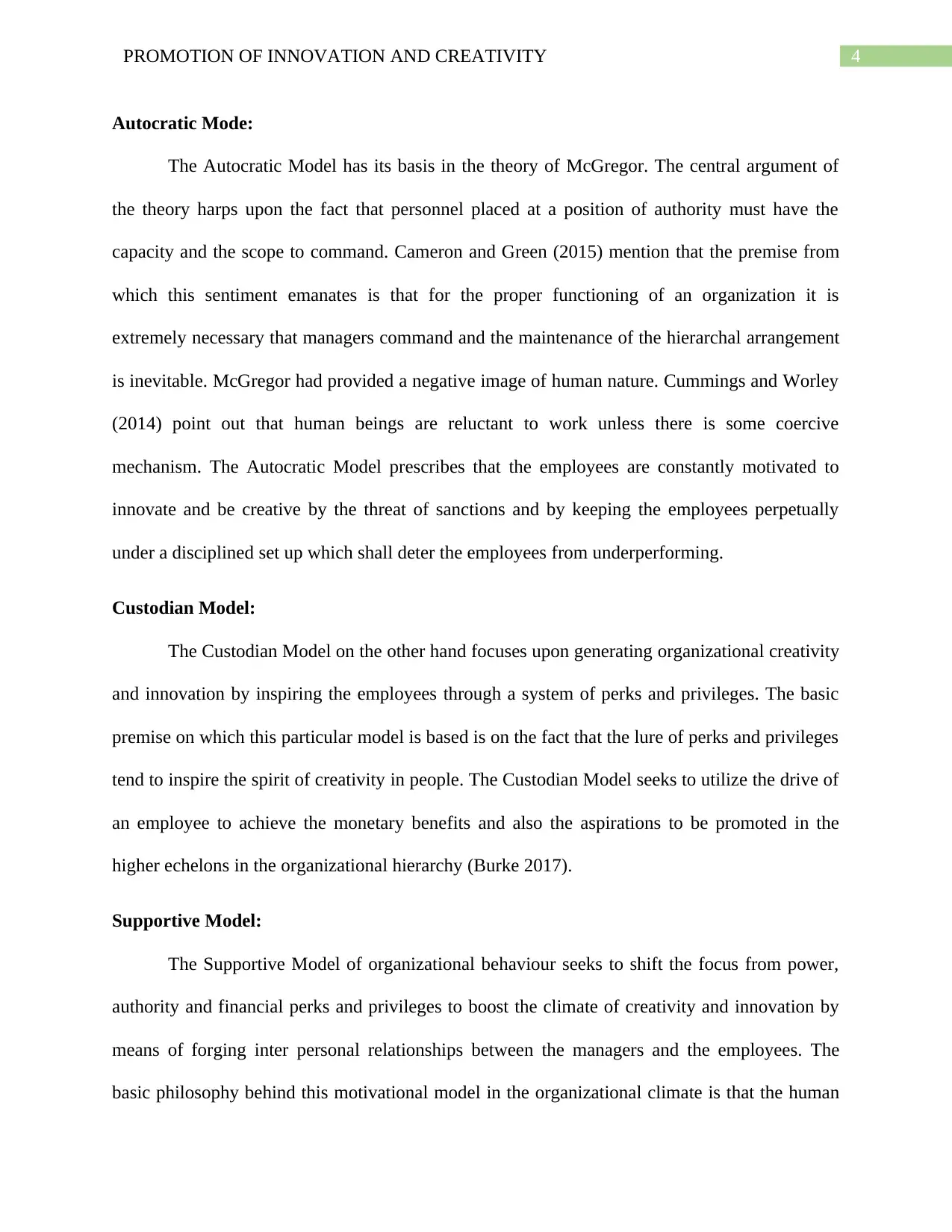
4PROMOTION OF INNOVATION AND CREATIVITY
Autocratic Mode:
The Autocratic Model has its basis in the theory of McGregor. The central argument of
the theory harps upon the fact that personnel placed at a position of authority must have the
capacity and the scope to command. Cameron and Green (2015) mention that the premise from
which this sentiment emanates is that for the proper functioning of an organization it is
extremely necessary that managers command and the maintenance of the hierarchal arrangement
is inevitable. McGregor had provided a negative image of human nature. Cummings and Worley
(2014) point out that human beings are reluctant to work unless there is some coercive
mechanism. The Autocratic Model prescribes that the employees are constantly motivated to
innovate and be creative by the threat of sanctions and by keeping the employees perpetually
under a disciplined set up which shall deter the employees from underperforming.
Custodian Model:
The Custodian Model on the other hand focuses upon generating organizational creativity
and innovation by inspiring the employees through a system of perks and privileges. The basic
premise on which this particular model is based is on the fact that the lure of perks and privileges
tend to inspire the spirit of creativity in people. The Custodian Model seeks to utilize the drive of
an employee to achieve the monetary benefits and also the aspirations to be promoted in the
higher echelons in the organizational hierarchy (Burke 2017).
Supportive Model:
The Supportive Model of organizational behaviour seeks to shift the focus from power,
authority and financial perks and privileges to boost the climate of creativity and innovation by
means of forging inter personal relationships between the managers and the employees. The
basic philosophy behind this motivational model in the organizational climate is that the human
Autocratic Mode:
The Autocratic Model has its basis in the theory of McGregor. The central argument of
the theory harps upon the fact that personnel placed at a position of authority must have the
capacity and the scope to command. Cameron and Green (2015) mention that the premise from
which this sentiment emanates is that for the proper functioning of an organization it is
extremely necessary that managers command and the maintenance of the hierarchal arrangement
is inevitable. McGregor had provided a negative image of human nature. Cummings and Worley
(2014) point out that human beings are reluctant to work unless there is some coercive
mechanism. The Autocratic Model prescribes that the employees are constantly motivated to
innovate and be creative by the threat of sanctions and by keeping the employees perpetually
under a disciplined set up which shall deter the employees from underperforming.
Custodian Model:
The Custodian Model on the other hand focuses upon generating organizational creativity
and innovation by inspiring the employees through a system of perks and privileges. The basic
premise on which this particular model is based is on the fact that the lure of perks and privileges
tend to inspire the spirit of creativity in people. The Custodian Model seeks to utilize the drive of
an employee to achieve the monetary benefits and also the aspirations to be promoted in the
higher echelons in the organizational hierarchy (Burke 2017).
Supportive Model:
The Supportive Model of organizational behaviour seeks to shift the focus from power,
authority and financial perks and privileges to boost the climate of creativity and innovation by
means of forging inter personal relationships between the managers and the employees. The
basic philosophy behind this motivational model in the organizational climate is that the human
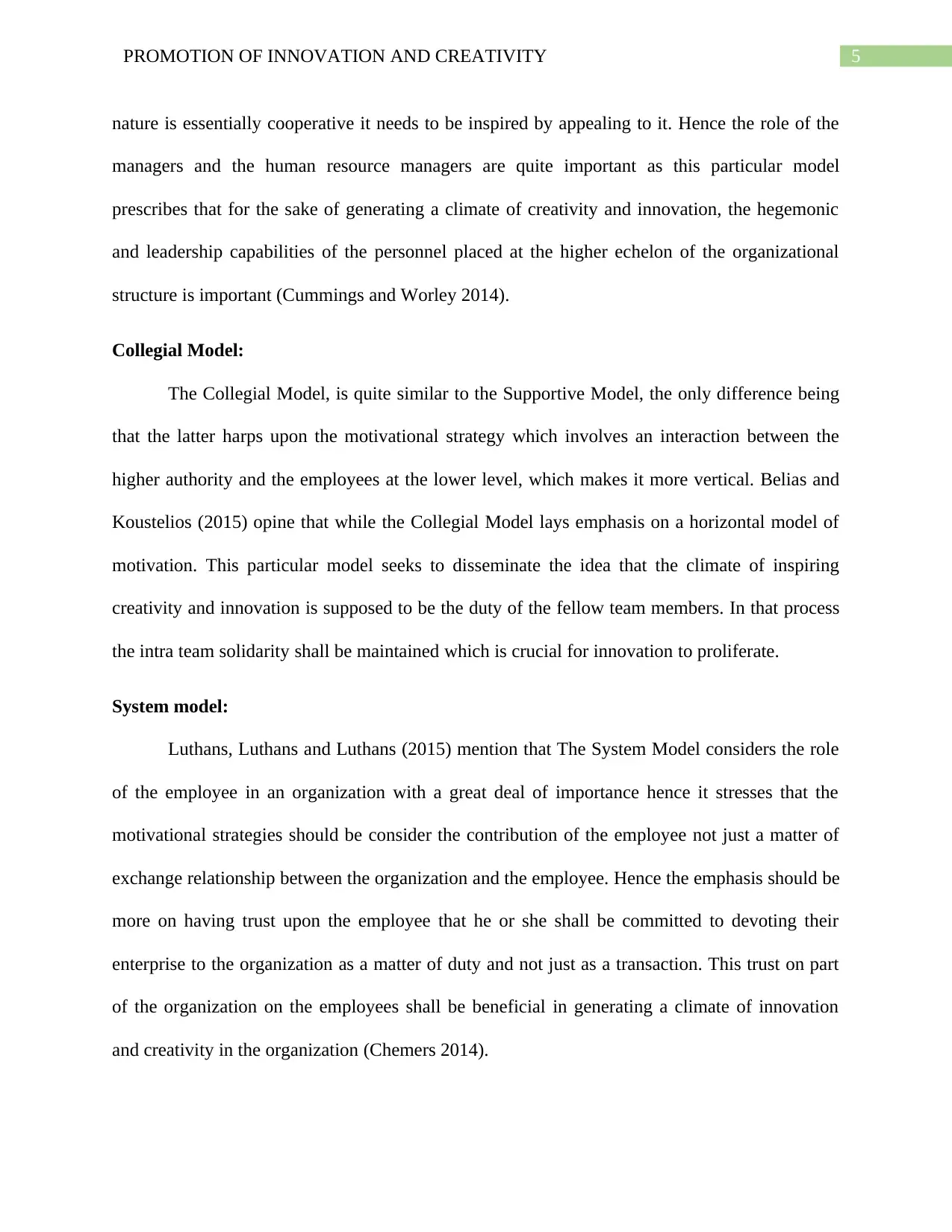
5PROMOTION OF INNOVATION AND CREATIVITY
nature is essentially cooperative it needs to be inspired by appealing to it. Hence the role of the
managers and the human resource managers are quite important as this particular model
prescribes that for the sake of generating a climate of creativity and innovation, the hegemonic
and leadership capabilities of the personnel placed at the higher echelon of the organizational
structure is important (Cummings and Worley 2014).
Collegial Model:
The Collegial Model, is quite similar to the Supportive Model, the only difference being
that the latter harps upon the motivational strategy which involves an interaction between the
higher authority and the employees at the lower level, which makes it more vertical. Belias and
Koustelios (2015) opine that while the Collegial Model lays emphasis on a horizontal model of
motivation. This particular model seeks to disseminate the idea that the climate of inspiring
creativity and innovation is supposed to be the duty of the fellow team members. In that process
the intra team solidarity shall be maintained which is crucial for innovation to proliferate.
System model:
Luthans, Luthans and Luthans (2015) mention that The System Model considers the role
of the employee in an organization with a great deal of importance hence it stresses that the
motivational strategies should be consider the contribution of the employee not just a matter of
exchange relationship between the organization and the employee. Hence the emphasis should be
more on having trust upon the employee that he or she shall be committed to devoting their
enterprise to the organization as a matter of duty and not just as a transaction. This trust on part
of the organization on the employees shall be beneficial in generating a climate of innovation
and creativity in the organization (Chemers 2014).
nature is essentially cooperative it needs to be inspired by appealing to it. Hence the role of the
managers and the human resource managers are quite important as this particular model
prescribes that for the sake of generating a climate of creativity and innovation, the hegemonic
and leadership capabilities of the personnel placed at the higher echelon of the organizational
structure is important (Cummings and Worley 2014).
Collegial Model:
The Collegial Model, is quite similar to the Supportive Model, the only difference being
that the latter harps upon the motivational strategy which involves an interaction between the
higher authority and the employees at the lower level, which makes it more vertical. Belias and
Koustelios (2015) opine that while the Collegial Model lays emphasis on a horizontal model of
motivation. This particular model seeks to disseminate the idea that the climate of inspiring
creativity and innovation is supposed to be the duty of the fellow team members. In that process
the intra team solidarity shall be maintained which is crucial for innovation to proliferate.
System model:
Luthans, Luthans and Luthans (2015) mention that The System Model considers the role
of the employee in an organization with a great deal of importance hence it stresses that the
motivational strategies should be consider the contribution of the employee not just a matter of
exchange relationship between the organization and the employee. Hence the emphasis should be
more on having trust upon the employee that he or she shall be committed to devoting their
enterprise to the organization as a matter of duty and not just as a transaction. This trust on part
of the organization on the employees shall be beneficial in generating a climate of innovation
and creativity in the organization (Chemers 2014).
⊘ This is a preview!⊘
Do you want full access?
Subscribe today to unlock all pages.

Trusted by 1+ million students worldwide
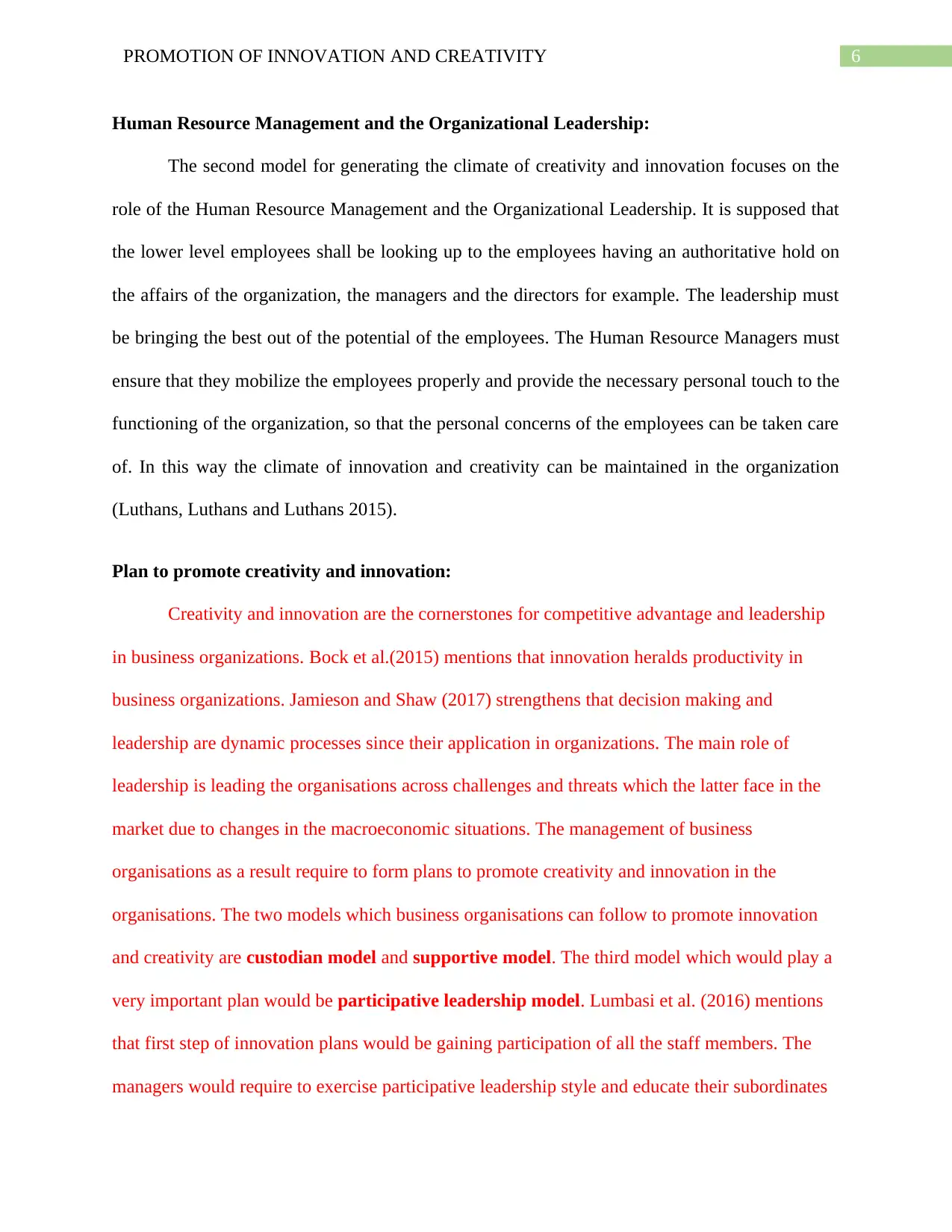
6PROMOTION OF INNOVATION AND CREATIVITY
Human Resource Management and the Organizational Leadership:
The second model for generating the climate of creativity and innovation focuses on the
role of the Human Resource Management and the Organizational Leadership. It is supposed that
the lower level employees shall be looking up to the employees having an authoritative hold on
the affairs of the organization, the managers and the directors for example. The leadership must
be bringing the best out of the potential of the employees. The Human Resource Managers must
ensure that they mobilize the employees properly and provide the necessary personal touch to the
functioning of the organization, so that the personal concerns of the employees can be taken care
of. In this way the climate of innovation and creativity can be maintained in the organization
(Luthans, Luthans and Luthans 2015).
Plan to promote creativity and innovation:
Creativity and innovation are the cornerstones for competitive advantage and leadership
in business organizations. Bock et al.(2015) mentions that innovation heralds productivity in
business organizations. Jamieson and Shaw (2017) strengthens that decision making and
leadership are dynamic processes since their application in organizations. The main role of
leadership is leading the organisations across challenges and threats which the latter face in the
market due to changes in the macroeconomic situations. The management of business
organisations as a result require to form plans to promote creativity and innovation in the
organisations. The two models which business organisations can follow to promote innovation
and creativity are custodian model and supportive model. The third model which would play a
very important plan would be participative leadership model. Lumbasi et al. (2016) mentions
that first step of innovation plans would be gaining participation of all the staff members. The
managers would require to exercise participative leadership style and educate their subordinates
Human Resource Management and the Organizational Leadership:
The second model for generating the climate of creativity and innovation focuses on the
role of the Human Resource Management and the Organizational Leadership. It is supposed that
the lower level employees shall be looking up to the employees having an authoritative hold on
the affairs of the organization, the managers and the directors for example. The leadership must
be bringing the best out of the potential of the employees. The Human Resource Managers must
ensure that they mobilize the employees properly and provide the necessary personal touch to the
functioning of the organization, so that the personal concerns of the employees can be taken care
of. In this way the climate of innovation and creativity can be maintained in the organization
(Luthans, Luthans and Luthans 2015).
Plan to promote creativity and innovation:
Creativity and innovation are the cornerstones for competitive advantage and leadership
in business organizations. Bock et al.(2015) mentions that innovation heralds productivity in
business organizations. Jamieson and Shaw (2017) strengthens that decision making and
leadership are dynamic processes since their application in organizations. The main role of
leadership is leading the organisations across challenges and threats which the latter face in the
market due to changes in the macroeconomic situations. The management of business
organisations as a result require to form plans to promote creativity and innovation in the
organisations. The two models which business organisations can follow to promote innovation
and creativity are custodian model and supportive model. The third model which would play a
very important plan would be participative leadership model. Lumbasi et al. (2016) mentions
that first step of innovation plans would be gaining participation of all the staff members. The
managers would require to exercise participative leadership style and educate their subordinates
Paraphrase This Document
Need a fresh take? Get an instant paraphrase of this document with our AI Paraphraser
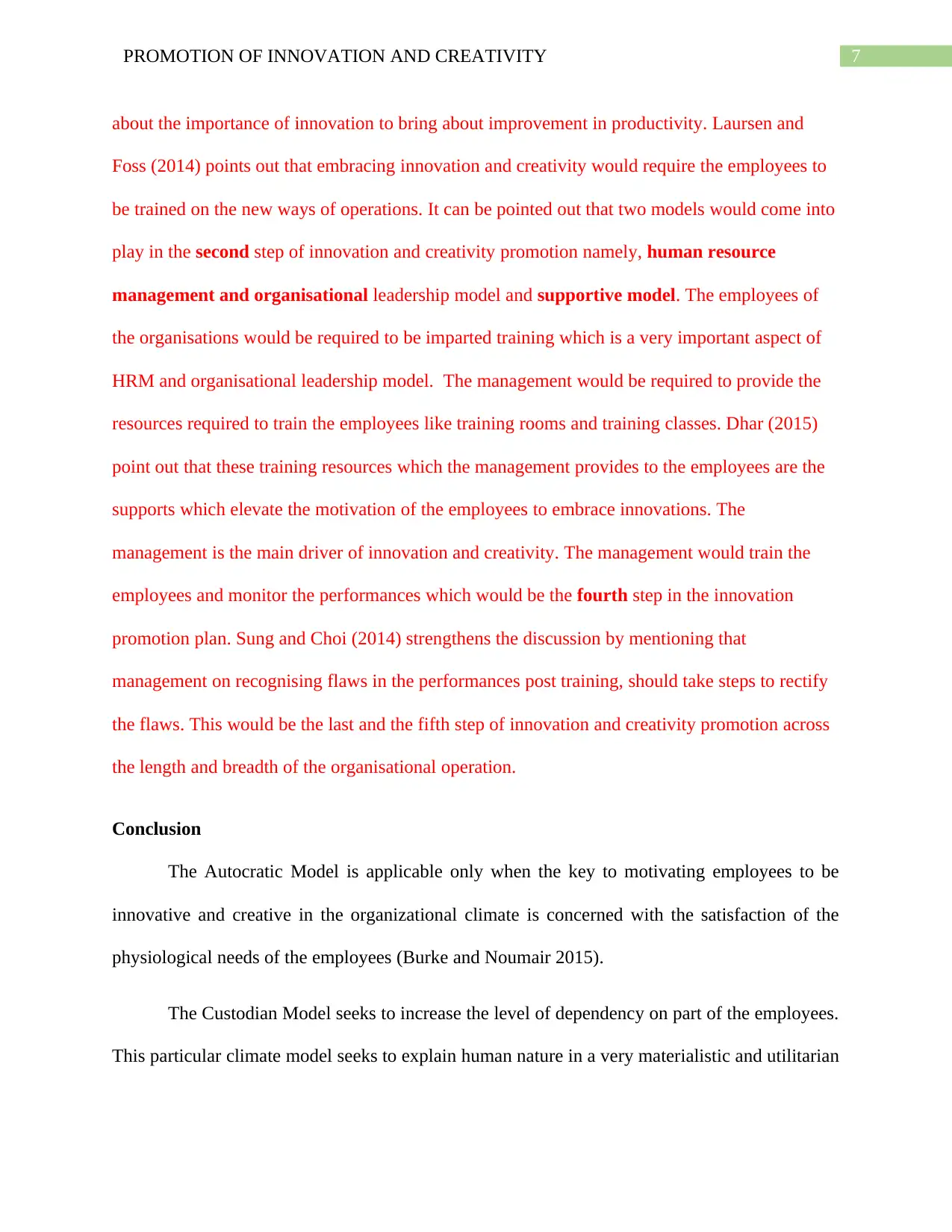
7PROMOTION OF INNOVATION AND CREATIVITY
about the importance of innovation to bring about improvement in productivity. Laursen and
Foss (2014) points out that embracing innovation and creativity would require the employees to
be trained on the new ways of operations. It can be pointed out that two models would come into
play in the second step of innovation and creativity promotion namely, human resource
management and organisational leadership model and supportive model. The employees of
the organisations would be required to be imparted training which is a very important aspect of
HRM and organisational leadership model. The management would be required to provide the
resources required to train the employees like training rooms and training classes. Dhar (2015)
point out that these training resources which the management provides to the employees are the
supports which elevate the motivation of the employees to embrace innovations. The
management is the main driver of innovation and creativity. The management would train the
employees and monitor the performances which would be the fourth step in the innovation
promotion plan. Sung and Choi (2014) strengthens the discussion by mentioning that
management on recognising flaws in the performances post training, should take steps to rectify
the flaws. This would be the last and the fifth step of innovation and creativity promotion across
the length and breadth of the organisational operation.
Conclusion
The Autocratic Model is applicable only when the key to motivating employees to be
innovative and creative in the organizational climate is concerned with the satisfaction of the
physiological needs of the employees (Burke and Noumair 2015).
The Custodian Model seeks to increase the level of dependency on part of the employees.
This particular climate model seeks to explain human nature in a very materialistic and utilitarian
about the importance of innovation to bring about improvement in productivity. Laursen and
Foss (2014) points out that embracing innovation and creativity would require the employees to
be trained on the new ways of operations. It can be pointed out that two models would come into
play in the second step of innovation and creativity promotion namely, human resource
management and organisational leadership model and supportive model. The employees of
the organisations would be required to be imparted training which is a very important aspect of
HRM and organisational leadership model. The management would be required to provide the
resources required to train the employees like training rooms and training classes. Dhar (2015)
point out that these training resources which the management provides to the employees are the
supports which elevate the motivation of the employees to embrace innovations. The
management is the main driver of innovation and creativity. The management would train the
employees and monitor the performances which would be the fourth step in the innovation
promotion plan. Sung and Choi (2014) strengthens the discussion by mentioning that
management on recognising flaws in the performances post training, should take steps to rectify
the flaws. This would be the last and the fifth step of innovation and creativity promotion across
the length and breadth of the organisational operation.
Conclusion
The Autocratic Model is applicable only when the key to motivating employees to be
innovative and creative in the organizational climate is concerned with the satisfaction of the
physiological needs of the employees (Burke and Noumair 2015).
The Custodian Model seeks to increase the level of dependency on part of the employees.
This particular climate model seeks to explain human nature in a very materialistic and utilitarian
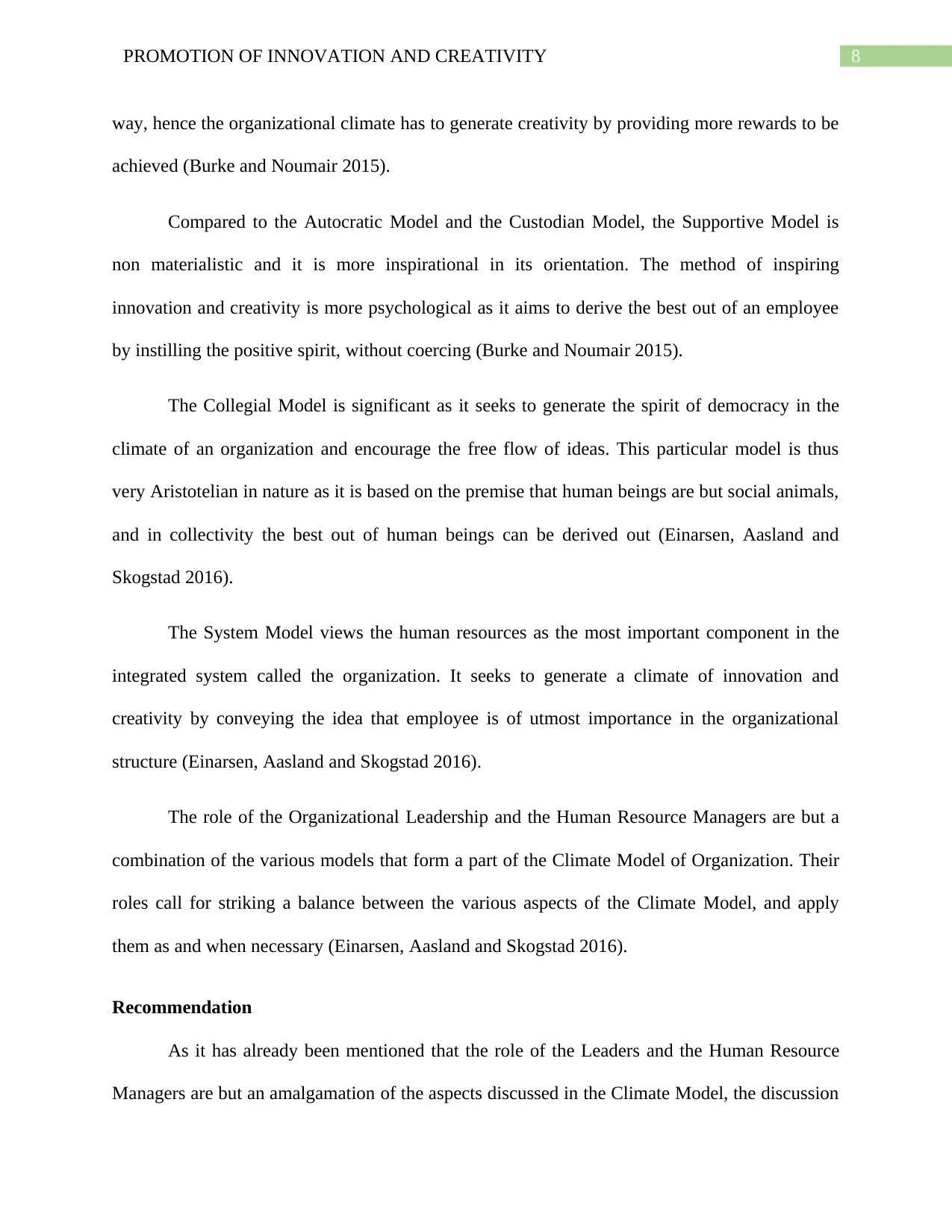
8PROMOTION OF INNOVATION AND CREATIVITY
way, hence the organizational climate has to generate creativity by providing more rewards to be
achieved (Burke and Noumair 2015).
Compared to the Autocratic Model and the Custodian Model, the Supportive Model is
non materialistic and it is more inspirational in its orientation. The method of inspiring
innovation and creativity is more psychological as it aims to derive the best out of an employee
by instilling the positive spirit, without coercing (Burke and Noumair 2015).
The Collegial Model is significant as it seeks to generate the spirit of democracy in the
climate of an organization and encourage the free flow of ideas. This particular model is thus
very Aristotelian in nature as it is based on the premise that human beings are but social animals,
and in collectivity the best out of human beings can be derived out (Einarsen, Aasland and
Skogstad 2016).
The System Model views the human resources as the most important component in the
integrated system called the organization. It seeks to generate a climate of innovation and
creativity by conveying the idea that employee is of utmost importance in the organizational
structure (Einarsen, Aasland and Skogstad 2016).
The role of the Organizational Leadership and the Human Resource Managers are but a
combination of the various models that form a part of the Climate Model of Organization. Their
roles call for striking a balance between the various aspects of the Climate Model, and apply
them as and when necessary (Einarsen, Aasland and Skogstad 2016).
Recommendation
As it has already been mentioned that the role of the Leaders and the Human Resource
Managers are but an amalgamation of the aspects discussed in the Climate Model, the discussion
way, hence the organizational climate has to generate creativity by providing more rewards to be
achieved (Burke and Noumair 2015).
Compared to the Autocratic Model and the Custodian Model, the Supportive Model is
non materialistic and it is more inspirational in its orientation. The method of inspiring
innovation and creativity is more psychological as it aims to derive the best out of an employee
by instilling the positive spirit, without coercing (Burke and Noumair 2015).
The Collegial Model is significant as it seeks to generate the spirit of democracy in the
climate of an organization and encourage the free flow of ideas. This particular model is thus
very Aristotelian in nature as it is based on the premise that human beings are but social animals,
and in collectivity the best out of human beings can be derived out (Einarsen, Aasland and
Skogstad 2016).
The System Model views the human resources as the most important component in the
integrated system called the organization. It seeks to generate a climate of innovation and
creativity by conveying the idea that employee is of utmost importance in the organizational
structure (Einarsen, Aasland and Skogstad 2016).
The role of the Organizational Leadership and the Human Resource Managers are but a
combination of the various models that form a part of the Climate Model of Organization. Their
roles call for striking a balance between the various aspects of the Climate Model, and apply
them as and when necessary (Einarsen, Aasland and Skogstad 2016).
Recommendation
As it has already been mentioned that the role of the Leaders and the Human Resource
Managers are but an amalgamation of the aspects discussed in the Climate Model, the discussion
⊘ This is a preview!⊘
Do you want full access?
Subscribe today to unlock all pages.

Trusted by 1+ million students worldwide
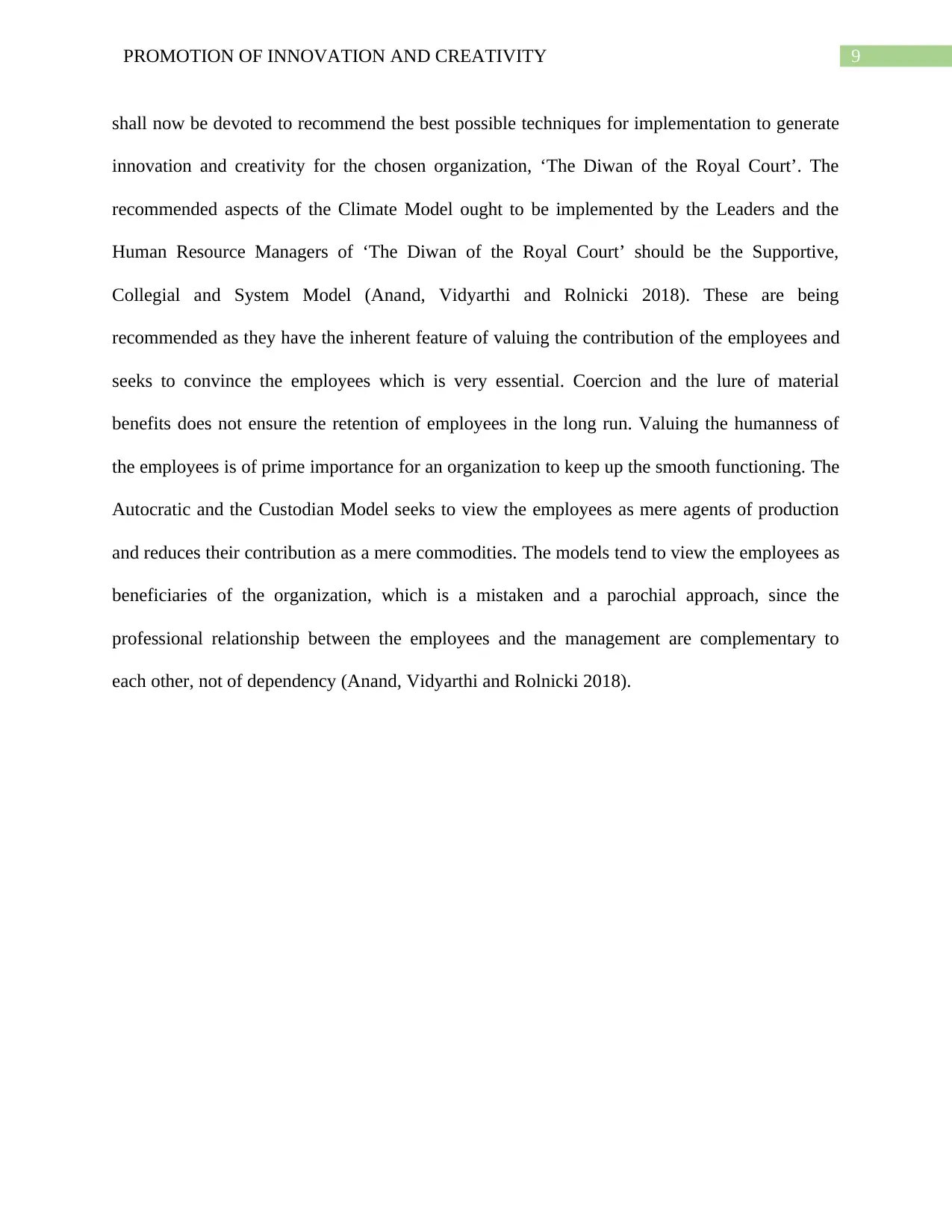
9PROMOTION OF INNOVATION AND CREATIVITY
shall now be devoted to recommend the best possible techniques for implementation to generate
innovation and creativity for the chosen organization, ‘The Diwan of the Royal Court’. The
recommended aspects of the Climate Model ought to be implemented by the Leaders and the
Human Resource Managers of ‘The Diwan of the Royal Court’ should be the Supportive,
Collegial and System Model (Anand, Vidyarthi and Rolnicki 2018). These are being
recommended as they have the inherent feature of valuing the contribution of the employees and
seeks to convince the employees which is very essential. Coercion and the lure of material
benefits does not ensure the retention of employees in the long run. Valuing the humanness of
the employees is of prime importance for an organization to keep up the smooth functioning. The
Autocratic and the Custodian Model seeks to view the employees as mere agents of production
and reduces their contribution as a mere commodities. The models tend to view the employees as
beneficiaries of the organization, which is a mistaken and a parochial approach, since the
professional relationship between the employees and the management are complementary to
each other, not of dependency (Anand, Vidyarthi and Rolnicki 2018).
shall now be devoted to recommend the best possible techniques for implementation to generate
innovation and creativity for the chosen organization, ‘The Diwan of the Royal Court’. The
recommended aspects of the Climate Model ought to be implemented by the Leaders and the
Human Resource Managers of ‘The Diwan of the Royal Court’ should be the Supportive,
Collegial and System Model (Anand, Vidyarthi and Rolnicki 2018). These are being
recommended as they have the inherent feature of valuing the contribution of the employees and
seeks to convince the employees which is very essential. Coercion and the lure of material
benefits does not ensure the retention of employees in the long run. Valuing the humanness of
the employees is of prime importance for an organization to keep up the smooth functioning. The
Autocratic and the Custodian Model seeks to view the employees as mere agents of production
and reduces their contribution as a mere commodities. The models tend to view the employees as
beneficiaries of the organization, which is a mistaken and a parochial approach, since the
professional relationship between the employees and the management are complementary to
each other, not of dependency (Anand, Vidyarthi and Rolnicki 2018).
Paraphrase This Document
Need a fresh take? Get an instant paraphrase of this document with our AI Paraphraser
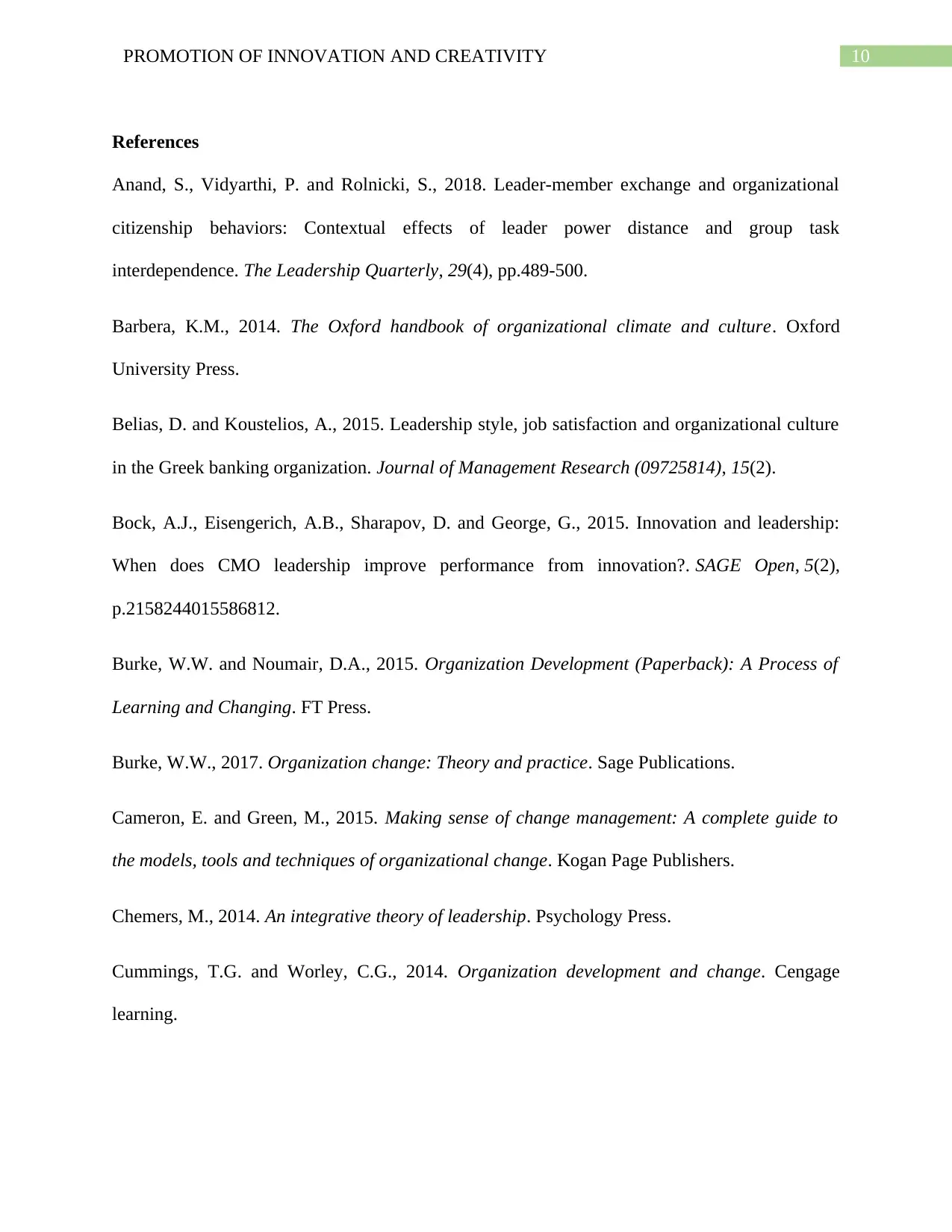
10PROMOTION OF INNOVATION AND CREATIVITY
References
Anand, S., Vidyarthi, P. and Rolnicki, S., 2018. Leader-member exchange and organizational
citizenship behaviors: Contextual effects of leader power distance and group task
interdependence. The Leadership Quarterly, 29(4), pp.489-500.
Barbera, K.M., 2014. The Oxford handbook of organizational climate and culture. Oxford
University Press.
Belias, D. and Koustelios, A., 2015. Leadership style, job satisfaction and organizational culture
in the Greek banking organization. Journal of Management Research (09725814), 15(2).
Bock, A.J., Eisengerich, A.B., Sharapov, D. and George, G., 2015. Innovation and leadership:
When does CMO leadership improve performance from innovation?. SAGE Open, 5(2),
p.2158244015586812.
Burke, W.W. and Noumair, D.A., 2015. Organization Development (Paperback): A Process of
Learning and Changing. FT Press.
Burke, W.W., 2017. Organization change: Theory and practice. Sage Publications.
Cameron, E. and Green, M., 2015. Making sense of change management: A complete guide to
the models, tools and techniques of organizational change. Kogan Page Publishers.
Chemers, M., 2014. An integrative theory of leadership. Psychology Press.
Cummings, T.G. and Worley, C.G., 2014. Organization development and change. Cengage
learning.
References
Anand, S., Vidyarthi, P. and Rolnicki, S., 2018. Leader-member exchange and organizational
citizenship behaviors: Contextual effects of leader power distance and group task
interdependence. The Leadership Quarterly, 29(4), pp.489-500.
Barbera, K.M., 2014. The Oxford handbook of organizational climate and culture. Oxford
University Press.
Belias, D. and Koustelios, A., 2015. Leadership style, job satisfaction and organizational culture
in the Greek banking organization. Journal of Management Research (09725814), 15(2).
Bock, A.J., Eisengerich, A.B., Sharapov, D. and George, G., 2015. Innovation and leadership:
When does CMO leadership improve performance from innovation?. SAGE Open, 5(2),
p.2158244015586812.
Burke, W.W. and Noumair, D.A., 2015. Organization Development (Paperback): A Process of
Learning and Changing. FT Press.
Burke, W.W., 2017. Organization change: Theory and practice. Sage Publications.
Cameron, E. and Green, M., 2015. Making sense of change management: A complete guide to
the models, tools and techniques of organizational change. Kogan Page Publishers.
Chemers, M., 2014. An integrative theory of leadership. Psychology Press.
Cummings, T.G. and Worley, C.G., 2014. Organization development and change. Cengage
learning.
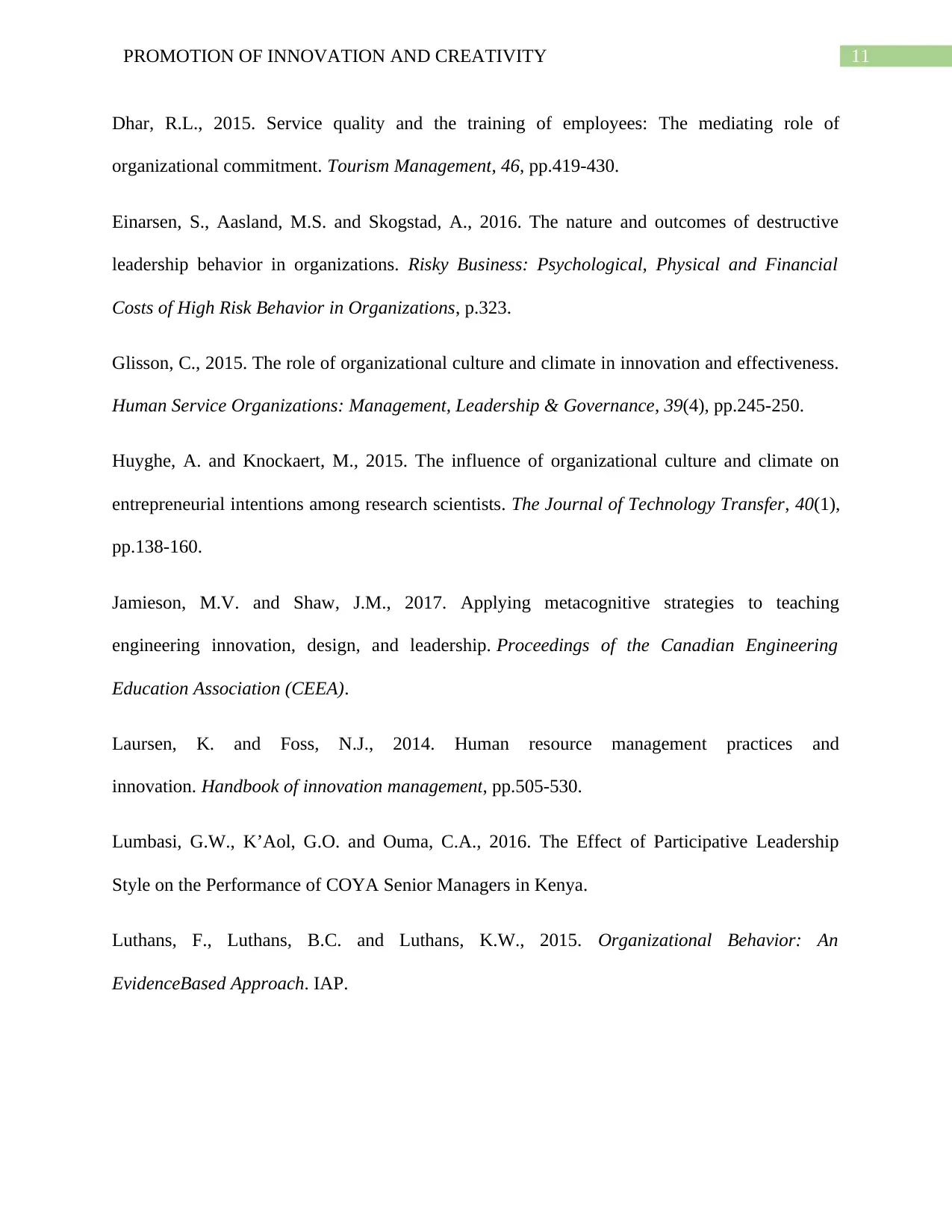
11PROMOTION OF INNOVATION AND CREATIVITY
Dhar, R.L., 2015. Service quality and the training of employees: The mediating role of
organizational commitment. Tourism Management, 46, pp.419-430.
Einarsen, S., Aasland, M.S. and Skogstad, A., 2016. The nature and outcomes of destructive
leadership behavior in organizations. Risky Business: Psychological, Physical and Financial
Costs of High Risk Behavior in Organizations, p.323.
Glisson, C., 2015. The role of organizational culture and climate in innovation and effectiveness.
Human Service Organizations: Management, Leadership & Governance, 39(4), pp.245-250.
Huyghe, A. and Knockaert, M., 2015. The influence of organizational culture and climate on
entrepreneurial intentions among research scientists. The Journal of Technology Transfer, 40(1),
pp.138-160.
Jamieson, M.V. and Shaw, J.M., 2017. Applying metacognitive strategies to teaching
engineering innovation, design, and leadership. Proceedings of the Canadian Engineering
Education Association (CEEA).
Laursen, K. and Foss, N.J., 2014. Human resource management practices and
innovation. Handbook of innovation management, pp.505-530.
Lumbasi, G.W., K’Aol, G.O. and Ouma, C.A., 2016. The Effect of Participative Leadership
Style on the Performance of COYA Senior Managers in Kenya.
Luthans, F., Luthans, B.C. and Luthans, K.W., 2015. Organizational Behavior: An
EvidenceBased Approach. IAP.
Dhar, R.L., 2015. Service quality and the training of employees: The mediating role of
organizational commitment. Tourism Management, 46, pp.419-430.
Einarsen, S., Aasland, M.S. and Skogstad, A., 2016. The nature and outcomes of destructive
leadership behavior in organizations. Risky Business: Psychological, Physical and Financial
Costs of High Risk Behavior in Organizations, p.323.
Glisson, C., 2015. The role of organizational culture and climate in innovation and effectiveness.
Human Service Organizations: Management, Leadership & Governance, 39(4), pp.245-250.
Huyghe, A. and Knockaert, M., 2015. The influence of organizational culture and climate on
entrepreneurial intentions among research scientists. The Journal of Technology Transfer, 40(1),
pp.138-160.
Jamieson, M.V. and Shaw, J.M., 2017. Applying metacognitive strategies to teaching
engineering innovation, design, and leadership. Proceedings of the Canadian Engineering
Education Association (CEEA).
Laursen, K. and Foss, N.J., 2014. Human resource management practices and
innovation. Handbook of innovation management, pp.505-530.
Lumbasi, G.W., K’Aol, G.O. and Ouma, C.A., 2016. The Effect of Participative Leadership
Style on the Performance of COYA Senior Managers in Kenya.
Luthans, F., Luthans, B.C. and Luthans, K.W., 2015. Organizational Behavior: An
EvidenceBased Approach. IAP.
⊘ This is a preview!⊘
Do you want full access?
Subscribe today to unlock all pages.

Trusted by 1+ million students worldwide
1 out of 14
Your All-in-One AI-Powered Toolkit for Academic Success.
+13062052269
info@desklib.com
Available 24*7 on WhatsApp / Email
![[object Object]](/_next/static/media/star-bottom.7253800d.svg)
Unlock your academic potential
Copyright © 2020–2025 A2Z Services. All Rights Reserved. Developed and managed by ZUCOL.